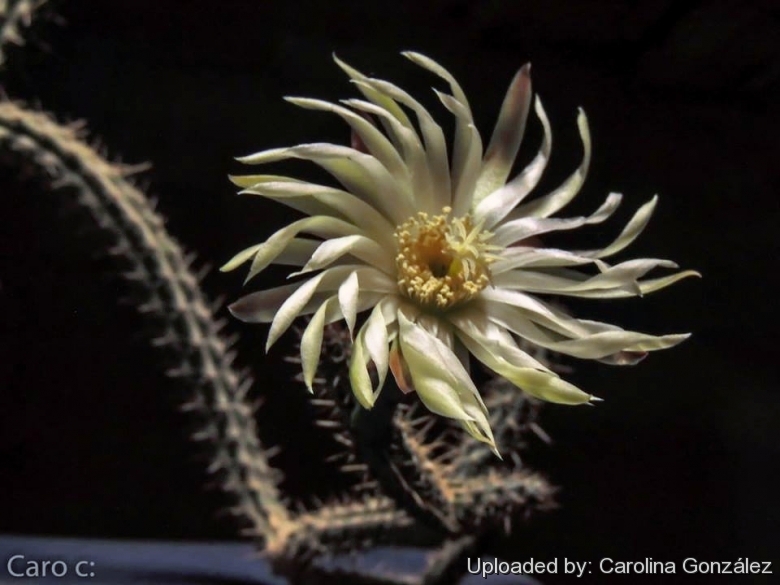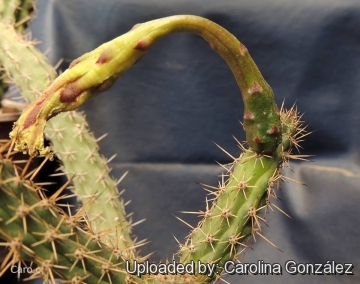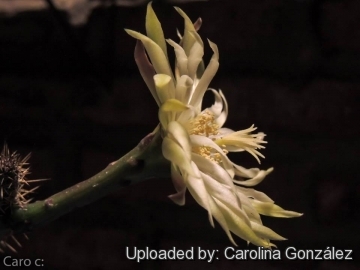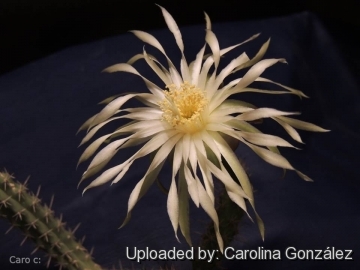
Praecereus saxicola Photo by: Carolina González
Origin and Habitat: Praecereus saxicolaSN|7705]]SN|7705]] is distributed in Argentina, Brazil, Bolivia, and Paraguay. This species is common and abundant throughout its range. In Brazil it is patchily distributed.
Altitude range: This species occurs at low elevations of 100 to 500(-900) metres above sea level.
Habitat and Ecology: This species occurs in many different habitats in the Chaco region. It frequently forms dense colonies in the sotobosque. In the northeastern portion of its range it grows in rocky areas. The native people eat the fruit of this species. It is also eaten by animals. In most of its range there are no major threats to this species. In Brazil, the main threat is habitat loss from deforestation for plantations for biofuels and livestock ranching.
Synonyms:
See all synonyms of Praecereus saxicola
back
Accepted name in llifle Database:Praecereus saxicola (Morong) N.P.TaylorCactaceae Consensus Init. 3: 10. 1997Synonymy: 18
back
Description: PraeSN'> 7705' alt='7716'>Cereus saxicola#SN#7707'>Prae[[Cereus saxicolaSN' style='border:none;'> (also known as Monvillea cavendishiiSN|7722]]SN|7722]] or Cereus rhodoleucanthusSN|7720]]SN|7716]]) is a sparse to richly branched thicket-forming shrub that scramble on the ground or work its way through tree branches. The fast-growing, stems can reach a height of more than 2 metres and 1.5 to 3 in diameter, and bear fine, short spines. PraeSN'>
7705' alt='7716'>Cereus saxicola#SN#7707'>Prae[[Cereus saxicolaSN' style='border:none;'> (also known as Monvillea cavendishiiSN|7722]]SN|7722]] or Cereus rhodoleucanthusSN|7720]]SN|7716]]) is a sparse to richly branched thicket-forming shrub that scramble on the ground or work its way through tree branches. The fast-growing, stems can reach a height of more than 2 metres and 1.5 to 3 in diameter, and bear fine, short spines. PraeSN'> 7705' alt='7707'>Cereus saxicola#SN#7707'>Prae[[Cereus saxicolaSN' style='border:none;'> is the best-known species, and is a prolific bloomer, putting out its nocturnal white flowers from from spring to autumn.
7705' alt='7707'>Cereus saxicola#SN#7707'>Prae[[Cereus saxicolaSN' style='border:none;'> is the best-known species, and is a prolific bloomer, putting out its nocturnal white flowers from from spring to autumn.
Derivation of specific name: 'saxicola' Latin 'saxum', rock; and Latin '-cola', inhabiting; Because it often grows on rocks.
Stems: Rather slender, cylindrical, flexible, ribbed, more or less branched at base, upright, arching, decumbent or clambering 1-3 m long, 2-3 cm, pale to dark green or blue green.
Ribs: 6 to 9 low and rounded.
Areoles. Small 5-15 mm apart.
Central spines; 1-4 needle-like up to 1.5(-2) cm long, dark brown or black.
Radial spines: 6 to 9 needle-like or bristly, white to yellowish brown with black tips, 2-6(-10) mm long.
Flowers: Funnel-shaped, hermaphrodite, actinomorphic, nocturnal, greenish white up to 10-13 centimeters long, 6-10 cm wide, outer perianth-segments pinkish or greenish, inner white, acute. Pericarpel small, with small scales naked in their axils; tube 5 to 6 cm long, with more distant scales, these broader than long, with minute brown chartaceous tips. The flowers arise from near the top on the sides of the stems.
Fruits: Spherical to ellipsoid, up to 5-7 cm wide, 4-5 centimeters in diameter fleshy, red, often grooved, almost naked or with sparse scales. The withered perianth persistent.
Blooming season: PraeSN'> 7705' alt='7707'>Cereus saxicola#SN#7707'>Prae[[Cereus saxicolaSN' style='border:none;'> is a prolific bloomer beginning to produce flowers in late spring and continuing into early autumn.
7705' alt='7707'>Cereus saxicola#SN#7707'>Prae[[Cereus saxicolaSN' style='border:none;'> is a prolific bloomer beginning to produce flowers in late spring and continuing into early autumn.
Seeds: black, obliquely obovate in outline.
History: The first description was published in 1893 by Thomas Morong as Cereus saxicolaSN|7707]]SN|7707]]. Nigel Paul Taylor set it the genus Praecereus in 1997. Synonyms include Cereus cavendishiiSN|7716]]SN|7720]] Monv. (1839) and Cereus rhodoleucanthusSN|7707]]SN|7716]] K.Schum. (1899).
Subspecies, varieties, forms and cultivars of plants belonging to the Praecereus saxicola group
 Monvillea cavendishii (Monv. ex Salm-Dyck) Britton & Rose: It is generally included within (as a synonym of) Praecereus saxicola , suggesting that there is not really a fundamental difference between the two.
Monvillea cavendishii (Monv. ex Salm-Dyck) Britton & Rose: It is generally included within (as a synonym of) Praecereus saxicola , suggesting that there is not really a fundamental difference between the two. Praecereus saxicola (Morong) N.P.Taylor: stems more than 2 metres long 1.5-3 cm Ø with fine, short spines. Flower 10-13 cm long, 6-10 cm Ø, tube slender without felt or spines. Distribution: Argentina, Brazil, Bolivia, and Paraguay.
Praecereus saxicola (Morong) N.P.Taylor: stems more than 2 metres long 1.5-3 cm Ø with fine, short spines. Flower 10-13 cm long, 6-10 cm Ø, tube slender without felt or spines. Distribution: Argentina, Brazil, Bolivia, and Paraguay.
Bibliography: Major rences and further lectures
1) Hunt, D., Taylor, N. and Charles, G. “The New Cactus Lexicon.” dh Books, Milborne Port, UK. 2006
2) Kiesling, R., Oakley, L. & Pin, A. 2013. Praecereus saxicola. The IUCN Red List of Threatened Species 2013: e.T152756A674714. http://dx.doi.org/10.2305/IUCN.UK.2013-1.RLTS.T152756A674714.en. Downloaded on 20 February 2016.
3) Edward Anderson “The Cactus family” Timber Press, Incorporated, 2001Cactaceae
4) “Consensus Initiatives.” 3: 10 1997
5) Haustein, “Der Kosmos-Kakteenführer”, 121 1983
6) James Cullen, Sabina G. Knees, H. Suzanne Cubey “The European Garden Flora Flowering Plants: A Manual for the Identification of Plants Cultivated in Europe, Both Out-of-Doors and Under Glass” Cambridge University Press, 11 August 2011
7) Urs Eggli, Leonard E. Newton “Etymological Dictionary of Succulent Plant Names” Springer Science & Business Media, 29 June 2013
8) N. L. Britton and J. N. Rose “The 'Cactaceae', Descriptions and Illustrations of Plants of the 'Cactus' Family” volume 2 Carnegie Institution, 1920
9) Edwin Arnold Menninger “Flowering vines of the world: an encyclopedia of climbing plants” Hearthside Press, 1970
10) Peter Loewer “The Evening Garden: Flowers and Fragrance from Dusk Till Dawn” Macmillan Publishing Company, 1993
11) Carroll C. Calkins “Great Gardens of America” Coward-McCann, 1969
12) Wilfred Edward Shewell Cooper “The ABC of Cacti and Succulents” English University Press, 1957
13) Edwin Arnold Menninger “Flowering vines of the world: an encyclopedia of climbing plants” Hearthside Press, 1970
 Praecereus saxicola Photo by: Carolina González
Praecereus saxicola Photo by: Carolina González Praecereus saxicola Photo by: Carolina González
Praecereus saxicola Photo by: Carolina González Praecereus saxicola Photo by: Carolina González
Praecereus saxicola Photo by: Carolina GonzálezSend a photo of this plant.The gallery now contains thousands of pictures, however it is possible to do even more. We are, of course, seeking photos of species not yet shown in the gallery but not only that, we are also looking for better pictures than those already present.
Read More... Cultivation and Propagation: Praecereus saxicolaSN|7705]]SN|7705]] is grown as an ornamental because of its beautiful nocturnal flowers. It is a fast growing plant that form thickets, the spiny stems often high-clambering or drooping, depending on where they grow. If you can keep it warm over the winter, then Praecereus saxicolaSN|7705]]SN|7705]] with its lovely flowers appearing during the night, is not as difficult as it is made out to be. It rarely planted outdoors in tropical countries, where climbs trees in a semi-naturalized state. In nature it climbs into trees. Older plants in the greenhouse buds freely.
Soil: It needs a compost containing plenty of humus and sufficient moisture in summer (though quite adaptable) it can be also cultivated on split bark like Monstera or in orchid substrate.
Moisture: The plant is quite resistant to drought condition, but shouldn't dry out totally otherwise it will turn purplish brown and look unpleasant and should be permitted to dry out entirely between watering
Fertilization: Too much fertilizer will cause a lot of lush growth at the expense of flowers.
Hardiness: Should not be kept under 5º C in winter.
Exposition: It perform best if grown in semi–shade but tolerate full sun. Extra light in the early spring will stimulate budding.
Uses: Praecereus saxicolaSN|7705]]SN|7705]], is often used as stock for grafting.
Propagation: By cuttings rootted in moss as an epiphyte.













